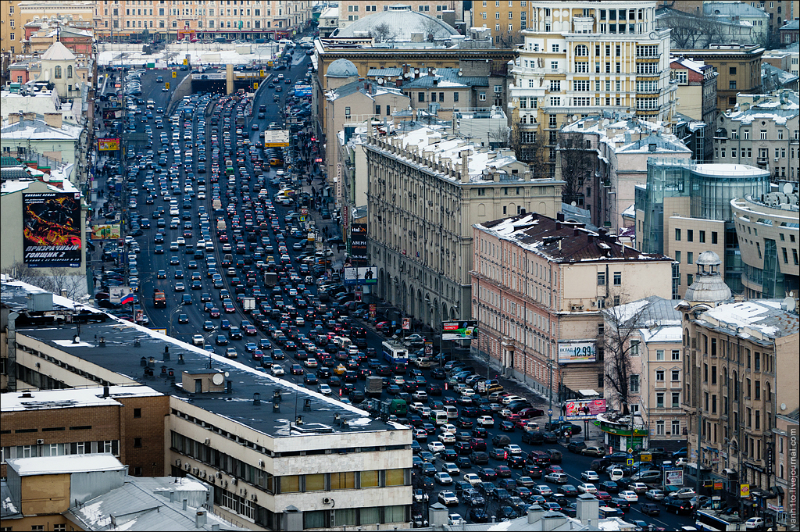Let me guess what kind of people predominantly lived in the neighborhoods that were bulldozed.

Blue=Black, Red=White.
So you have a before version?
No, that’s from 2000 I think.
Atlanta is still apparently the USA’s second most segregated city, so I can’t imagine it was a multicultural wonderland in the 1950s.
The article those pictures appear to be from says it was mostly black neighbourhoods demolished.
Sadly, I don’t think there’s enough uncertainty to consider it a guess.
Sure the designers of this monstrosity thought, “There are only black people living there, so it’s a win-win” -.-
You can thank Robert Moses for that.
The expressway must expand in order to acommodate the increasing needs of the expressway
Am I the only one who finds the 1950s version also not nice from an urban planning perspective? I mean, it is a car-centered design anyway.
Still, do you see how many trees there are? That place must’ve still looked nice and was certainly transformable into a really nice place without unreasonable effort.
Now, it’s basically a wasteland.
Yea just get rid of the poor people right?
Nah not really, such low population density requires cars to be used. If you think tearing that down would be simple, then yes. But I think that even in Atlanta that would be difficult. The reason why those highways are there is that more people wanted to live in that kind of neighborhood.
such low population density requires cars to be used
As someone living in a much less dense area, I wholeheartedly disagree. Even just a single tram stop with >=bi-hourly frequency near the center could make that entire area car-free if the people weren’t car-brained. That area looks like it’d be bikable in <10min side-to-side, so most people could probably even walk to such a tram stop.
(That tram would actually need to go somewhere but that’s part of a larger system’s problem, not of this hypothetical neighbourhood.)
There are a lot of assumptions there.
First of all, I am sure that is part of something much larger and it is a real neighborhood, not something hypothetical.
Second, I don’t see people giving up their car brains just because you put a tram. I myself would still be using a car if it wasn’t made completely superfluous and fatiguing where I live and work.
There are a lot of assumptions there.
Absolutely.
I am sure that is part of something much larger and it is a real neighborhood, not something hypothetical.
I’d agree but I don’t see how that makes a difference. My point was that the visible part could be served by even just one tram station. If there are more such parts, you’d obviously need tram stops for those aswell. (More tram stops would realistically be necessary anyways.)
I don’t see people giving up their car brains just because you put a tram.
Me neither. Point was that it’d be possible for those people to reasonably get where they need to go without any cars involved with as little infrastructure as a single tram stop.
The former streetcars aren’t an “assumption;” they’re historical fact. Here’s the damn map!

That was not the assumption. Also, that map is either 20something years too early or too late to be proof of much of what was going on in the 1950s.
The reason why those highways are there is that more people wanted to live in that kind of neighborhood.
No, those highways are there because white men got together and intentionally chose to put the highway there with complete disregard (or quite possibly, with malice) for the people who lived there.
No, the 1950s version (actually more like 1900s; those houses were already decades old at the time they were photographed) was good. It was a traditional street grid with small blocks, and there were streetcars going all over the place. Sure it was mostly single-family (probably with more than a few duplexes sprinkled in), but it had great bones for densifying later when demand justified it.
I live only a few miles from the area pictured, in a neighborhood with the same development pattern. Even though it’s been damaged by the removal of the old streetcars and having zoning superimposed upon it after the fact (which causes problems by mandating things like too-large setbacks and minimum parking requirements, as well as outlawing corner stores within residential areas), it’s still mostly fine.
That’s what I was thinking. Neither solve the problem. The 1950s one just resulted in bigger traffic jams. What solves the problem is robust public transportation.
JUST ONE MORE LAME,I SWEAR TO GOD, JUST ONE MORE LANE AND WE’RE DONE. ONE MOAR LANE. MOAAAAR

A little lane of asphalt please,
More pollution if I freeze,
Running over children these,
A fresh bouquet of cancers.
(Parody of Glass of Water)
“Trains Are Too Expensive And Would Take Years To Build“ - guy who remembers the interstate being built.
“only roads pay for themselves”
Looks like what happens with headphone cables in the pocket.
I’ve been playing cities skyline and I’ll be honest, when my city gets like that I just restart.
And in Cities Skyline you can just pause time, delete and fix a bunch of shit, and continue. Instant and nobody complains that you just bulldozed their house.
I think highways would look nicer if real city planners had the ability to redesign everything vs add on pieces over time.
I like to think that people who get relocated in my skylines games get compensated appropriately and receive decent support in their relocation.
Because video games are supposed to be a form of escapism and it doesn’t get more escapism than that :/
When you bulldoze houses in skylines and unpause you’ll notice your population goes down. Because they were inside the houses. That you bulldozed. Have a good day!
Nope, they’re temporarily not counted as residents because they’re enjoying an all expenses stay in the swankiest spot in town as they await their new construction!
Nice try!
And Cities Skylines massively fudges things by treating cars Jetsons-style (take up negligible space when sims get to their destination). If the game accurately modeled parking, it would be way worse (and no longer fun to play, which is why the developers didn’t do it).
Cities Skylines 2 fixes this a little, there’re actual parking lots built into businesses and extra parking lots you can build. The scale is still a little funky, but it’s more in line with the general scale of the game now.
Now play Workers and Resources?
Nice little neighborhood you got there. Would be a shame if someone needed a new highway, wouldn’t it?
Weird how it always goes through the minority neighborhood
deleted by creator
You can take this picture in just about any city in the US too. NYT did a pretty good piece about it, gifted so y’all can read it: Can Removing Highways Fix America’s Cities? https://www.nytimes.com/interactive/2021/05/27/climate/us-cities-highway-removal.html?unlocked_article_code=1.60w.uuX5.Oo4CsHZXGv8Q&smid=nytcore-android-share
Cool illustration, thanks!
Cities should be built around people, not motor vehicles.
@arc you mean, would we have to really use public transport ? 😟 🤔 @sexy_peach
Yes, or cycle / walk.
How do roads even end up like this? The cloverleaf is as extreme as I’m willing to drive through. If anything like this came up in Google maps for my drive I would just nope on home.
Engineer answer: being a stack interchange, it’s actually easier to navigate than a cloverleaf because there’s only one exit in each direction instead of separate “A” and “B” exits with an entrance ramp and weaving in between. The complexity in this case simply comes from the fact that it’s superimposed on top of what used to be a street grid, so they added a bunch of exits to local streets.
Big-picture answer: the desire to put freeways there in the first place is the product of mental illness.
Just follow the arrows
Yeah they only seem complicated from the air, on the ground you just read the signs and it’s always clear, or if you’re using your phone - just go in the lane it tells you
deleted by creator
It’s a good thing removing all those homes definitely didn’t cause or contribute to any way more serious problems in society. Right?
/s
Is that a swastika block?
Any block is a swastika block if you ignore the right set of roads.
But that’s not the block’s fault ;)
Hä? What? Where?
Above the highways a bit to the right. Partially visible.
Those are the state government offices next to the Capitol building. It’s not actually a swastika, but if it can be mistaken for one it’s not a great look. 😬
“What do you mean, why’s it got to be built?” he said. “It’s a bypass. You’ve got to build bypasses.” Bypasses are devices that allow some people to dash from point A to point B very fast while other people dash from point B to point A very fast.
@Pixelphoria @sexy_peach
Yesterday i studied the map from portugal… especially around Porto you find a phenomenon…Bypass for a Bypass for a Bypass for a Bypass…
A classical example for “one more lane will fix it” and “one more street will fix it too”…
NO! It won’t fix it.
You’ll love Dubai
It’s a quote from hitchhikers guide to the galaxy











